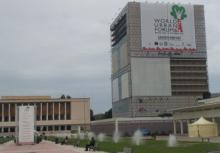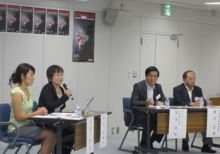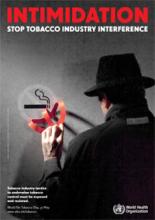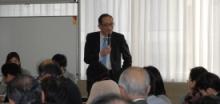2012

Mental Health Day

WKC networking event on “Empowering the Future of Cities” held at the 6th World Urban Forum in Naples, Italy
The World Urban Forum is organized by UN-HABITAT every second year and its 6th Forum took place this year in Naples, Italy, 1-7 September.
During the Forum, the WHO Kobe Centre held a networking event on “Empowering the Future of Cities: Addressing urban health and health equity through intersectoral action” on Monday, 3 September. This was one of the few events dedicated specifically to discussing health issues.
The event aimed to provide practical information on how to make cities more liveable and to assess and respond to urban health inequity through intersectoral action (sector collaboration and coordination).
Examples of intersectoral programmes were presented, and as practical guidance, the WHO “ten steps” for policy-makers to promote intersectoral action was shared.
Presentations:
- Mr Alex Ross, Director of WKC
Opening; WHO Ten Steps for Policy-makers to Implement Intersectoral Action on Health - Mr Jon Dawson, Jon Dawson Associates, United Kingdom
Intersectoral Action on Health in Urban Settings – Liverpool Active City 2005-2010 - Ms Maja Larsen, University of Southern Denmark
Challenges and Facilitators for Intersectoral Health Policy in a Danish Municipality

Assessing the impact of the ordinance banning smoking on selected streets in Kobe City, Hyogo, Japan
The WHO Kobe Centre is currently conducting a survey to assess impacts of the municipal street smoking ban ordinance in Kobe city in collaboration with the Department of Clinical Pharmacy of Kobe Pharmaceutical University. Professor Yamato from University of Occupational and Environmental Health Japan and the students from Kwansei Gakuin University "Cross-Cultural College – Canada-Japan Collaborative Program" have also been contributing to the project. Most of the ordinances on street smoking in Japan were implemented for environmental purposes; however, it is reasonable to expect that, properly implemented they could have health impacts, such as reducing exposure to second-hand smoke (SHS) on streets and facilitating smoking cessation among smokers.
Expected outcome of the survey include prevalence of smokers among pedestrians, number of smokers and cigarette butts, observed smoking behaviours, characteristics of the no-street-smoking zones, self-reported exposure to SHS, self-reported change in smoking behaviour, perception on smoking and tobacco control regulations and level of outdoor exposure to SHS on selected streets. As a result of analysis, the evidence gained through this research should help to further promote smoke-free environments and disseminate their benefits in cities with similar outdoor smoking restrictions.
A group of volunteer students from the Kobe Pharmaceutical University have taken the responsibility to carry most of the measures in the selected areas of Kobe city. They have participated with enthusiasm in the project, while having to face the challenging of the summer; they have shown great determination to make a contribution to the well-being of their fellow citizenships in Kobe.


Impact assessment: bringing sectors together to act on health
The UN General Assembly adopted the Political Declaration on Noncommunicable Diseases (NCDs) in 2011 and pledged to promote action through multisectoral action for health (MSA). However, MSA is a process that rarely occurs naturally and tools are needed to help facilitate and sustain the process.
On 20-22 June 2012, international experts, policy-makers and academics gathered at the WHO Centre for Health Development in Kobe to examine tools that will assist policy-makers to promote and sustain MSA.
Impact assessment has the potential to empower the health sector to develop an effective and mutually beneficial relationship with other sectors to coordinate action for health.

World No Tobacco Day 2012 - "Stop tobacco industry interference"
More than 60 participants came from academia, local governments and civil society groups to exchange their views and share ideas on tobacco industry interference on tobacco control policy in Japan.
The two-hour forum highlighted tobacco industry tactics to undermine tobacco control efforts, especially enforcement of smoke-free environments since Kanagawa and, this year, Hyogo adopted prefectural legislation to prevent public exposure to second-hand smoke.
Since the adoption of the WHO Framework Convention on Tobacco Control (FCTC) in 2004, Japan has struggled between the existing tobacco business related laws for the tobacco market and tobacco control plans to protect public health. Dr Yumiko Mochizuki, Division Chief of Tobacco Policy Research at the National Cancer Centre pointed out lack of Japan’s efforts in implementing measures on effective tobacco control policy based on the WHO FCTC and its guidelines and alerted that this has resulted in endangering public health and that public awareness should be raised for tobacco control policy to save lives.
Ms Mina Kashiwabara, Consultant at WHO Kobe Centre, presented on the Japanese tobacco industry’s intensive promotion of smoking manners and its impact on tobacco control policy. She emphasized that the industry’s smoking manners strategies have been used to avert the public attention from health impacts of smoking and to develop partnership with local governments to weaken tobacco control policy.
Kanagawa, the first prefecture to implement a local ordinance to regulate smoking in indoor public places in 2009, has also suffered from industry interference when developing the legislation. Mr Masatoshi Sekiguchi, a former member of the Kanagawa Prefecture Assembly shared a real life story of a tobacco company’s manipulation of public opinion – the tobacco company urged its employees to join Kanagawa’s opinion poll carried out in the beginning of the legislation to vote against regulating indoor public smoking.
Following the presentations, a vibrant discussion led by Dr Kohei Adachi, Vice President of Hyogo Prefecture Medical Association took place. Key issues, especially those encountered by the two prefectures, as well as broader trends in Japan of tobacco industry marketing and tactics hindering the implementation of tobacco control policy were discussed.
The forum ended with the closing remarks delivered by Mr Alex Ross, Director of WHO Kobe Centre. He emphasized the importance of full compliance to the WHO FCTC to protect public, and the commitment of WHO to promote health through stronger tobacco control measures.

World No Tobacco Day 2012
31st of May is World No Tobacco Day.
Each year, WHO and its member states celebrate World No Tobacco Day, highlighting the health risks associated with tobacco use and advocating for effective policies to reduce consumption.
World No Tobacco Day also promotes adherence to the WHO Framework Convention on Tobacco Control, an international treaty presenting obligations for all countries ratifying it. The theme for 2012 is “tobacco industry interference.”
In commemoration of this year's World No Tobacco Day, the WHO Centre for Health Development (WHO Kobe Centre) will organize an open forum in Kobe.
Date & venue:
31 May 2012 (Thursday) 15:00 –17:00
WHO Kobe Centre
Programme:
(language: Japanese)
15:00–15:10 Opening remarks
15:10–15:30 Tobacco control in Japan
15:30–15:50 Japan Tobacco’s manners campaign and local smoke-free policy
15:50–16:10 Kanagawa’s smoke-free legislation
16:10–16:50 Discussion
16:50–17:00 Closing remarks
Speakers:
(in order)
Dr Francisco Armada, WHO Kobe Centre
Dr Yumiko Mochizuki, Japan National Cancer Center
Ms Mina Kashiwabara, Consultant, WHO Kobe Centre
Mr Masatoshi Sekiguchi, former member of the Kanagawa Prefecture Assembly
Mr Alex Ross, WHO Kobe Centre
Moderator:
Dr Kohei Adachi, Hyogo Prefecture Medical Association

WKC Forum on Kaigo yobo interventions: the state of the art and future challenges in Japan
What are the future challenges facing the elderly? One of the many key questions posed during a forum attended by more than 60 participants at Hyogo Women’s Exchange Hall in Kobe City on 21 March, 2012.
Under the theme “Kaigo yobo: present and future challenges” the invited audience from many different spheres of interest, including universities, NGOs and local government, met to critically explore Japan’s current approaches on disability prevention. Kaigo yobo is a Japanese term that encompasses the notion of disability prevention among the elderly.
The two hour forum was opened by Mr Alex Ross, Director of the WHO Kobe Centre (WKC), followed by a brief introduction on the work of WKC by its Technical Officer on Urban Health Metrics, Dr Megumi Kano.
Keynote address - evaluating kaigo yobo:
Delivering the key note address was Dr Ichiro Kai of Tokyo University Graduate School of Medicine. He stressed the need to evaluate kaigo yobo programmes - including cost-benefit analysis - to demonstrate their effectiveness and value. However, he told the audience that the programmes should not be considered solely a health intervention, but also a “welfare” intervention. This therefore required subjective outcome indicators (e.g. quality of life etc.), though he admitted there were obvious challenges associated with conducting rigorous evaluations of this kind, especially in the community. He did close his speech on a note of optimism, with a call for the development of evidence-based kaigo yobo guidelines that are based on such procedures.
Research presentations: i) systematic review ii) evaluation methods:
Dr Kanako Masuno, a PhD researcher at Tokyo University, shared the findings from a systematic literature review on the effectiveness of disability prevention programmes both in Japan and overseas.
She said that there is plenty of evidence for the effectiveness of kaigo yobo in improving the physical health of the elderly, especially in fall prevention, but the effect of these programmes on other areas, such as on oral health, nutrition, cognition, mental health and social well-being is not yet well established.
Dr Yumi Kimura, a PhD researcher at Kyoto University, presented on recommended methods for evaluating kaigo yobo programmes and, specifically, on the utility of the healthy life expectancy indicator for monitoring and evaluating public health interventions.
A recent effort to standardize an evaluation method for kaigo yobo programmes nationally, was outlined, as were case examples of municipalities that showed the impacts of kaigo yobo programmes on health outcomes and healthcare costs.
On healthy life expectancy, an overview of the different calculation methods and the advantages and disadvantages of the indicator was shared, backed by examples of its use around the world. The potential for its use in Japan was also discussed.
Dr Kimura also presented findings from her field work on kaigo yobo programmes in Japan. She noted that despite the challenges, Japan’s programme is one of the most progressive in the world. She concluded with her vision of healthy ageing in the community with kaigo yobo, based on a multi-disciplinary, holistic approach.
Audience discussion:
The evening ended with the audience encouraged to share their experiences on kaigo yobo. Among the valid concerns was the gap between the needs of technical researchers and the needs of government officials who administer kaigo yobo. It was suggested this could be bridged by the two groups working more closely and by researchers addressing in their work the issues related to programme implementation.
Discussions also took place on evaluation methods – as highlighted during the key note address – as well as the need for greater awareness on gender sensitivities, for example, disease prevention among men, and musculoskeletal strengthening among women.
15th World Conference on Tobacco or Health (WCTOH)
Towards a Tobacco-Free World, Planning Globally, Acting Locally
WHO Kobe Centre (WKC) held a pre-conference workshop, “Making your city smoke-free - 12 steps to an effective smoke-free legislation”, at the 15th World Conference on Tobacco or Health 2012 in Singapore. The workshop was especially targeted at city-level policy-makers and tobacco control advocates. Tools to guide cities in making their cities smoke-free, developed by WKC and WHO Tobacco Free Initiative, were introduced. In addition, two guest speakers shared smoke-free experiences of Liverpool and Mexico City.
WKC Workshop Agenda:
Presentations:
WHO participates in UNEP Seminar on Tohoku Tsunami Debris Management
The United Nations Environment Programme (UNEP) held a seminar on the “Management of Debris Created by the Tohoku Tsunami” on 6 March at the UNEP International Environmental Technology Centre (IETC) in Osaka.
The seminar featured video highlights of the experts mission to Tohoku and the presentation of the key findings of the group of international experts that visited the Tohoku region to study debris management post tsunami. The team was organized by UNEP in response to the request of the Ministry of Foreign Affairs of Japan.
WHO was represented by the WKC Director Alex Ross and technical officers Jaz Lapitan and Art Pesigan. The WHO team took special interest in the aspect of hazardous wastes in the debris and also the protection of the response workers, the debris handlers and the community from health hazards of the debris. In collaboration with the Ministry of Foreign Affairs, UNEP will be releasing a video and a report containing key successful initiatives and technologies deployed in Japan for wider distribution internationally.

Safe Health Facilities and Preparedness for Mass Casualties
19 February 2012 marked the second time that the WHO Kobe Centre (WKC) and the University of Hyogo, Research Institute of Nursing Care for People and Community (RINCPC) organized a public health event at Akashi City. The first time was for a WKC Forum entitled “Strengthening disaster resilience: individual, group and community” held on 20 November 2011.
Attended by 80 participants from Bangladesh, Israel, Japan, Philippines, Thailand and USA, the University of Hyogo Seminar entitled “How do we make our hospital prepared for any disaster?” was moderated by Dr Aiko Yamamoto, Executive Director and Professor, RINCPC. The President of the University of Hyogo, Dr Masayoshi Kiyohara, welcomed the participants. He congratulated the University of Hyogo, College of Nursing, for being one of five nursing schools in Japan leading curriculum development on disaster nursing with an international perspective; and wished early on for a successful seminar.
Mr Alex Ross, Director, WKC, delivered WHO’s opening address. He remarked that the RINCPC is a very special place. As a WHO Collaborating Centre (WCC) for Nursing in Disasters and Health Emergency Management, it is the only such collaborating centre in the world on this topic, out of 800 collaborating centres worldwide, all of which are based in universities or in government institutions. Mr Ross expressed his pride of WKC’s association with the University of Hyogo and its WCC highlighting the role being played by nurses as first responders during emergencies – whether clinic-based or community-based.
The seminar’s first speaker was Dr Arturo Pesigan, Technical Officer, WKC, who spoke on “Making Hospitals Safer in Emergencies and Disasters”. Dr Pesigan shared images of a hospital in the Philippines before and after flash floods in 2009 due to Typhoon Ketsana which also devastated health facilities in Lao PDR and Viet Nam. He explained the historical background contributed by lessons learned from the Great Hanshin Awaji Earthquake and other disasters, the Hyogo Framework for Action, the World Disaster Reduction Campaign on safe schools and hospitals and the current work on disaster risk reduction in health facilities. He mentioned about a case study (integrating structural, non-structural and functional elements) on Kobe Red Cross Hospital and Kobe University Hospital conducted by WKC in 2007. He reiterated that “supporting hospitals and health facilities to make them safe in health emergencies involves everyone”.
Dr Hanna Admi, Director of Nursing, Rambam Health Care Campus, Haifa, Israel tackled “Mass Casualty Preparedness” in the second presentation. Dr Admi contextualized her inputs by showing at first video footages of the world’s most recent emergencies and disasters that struck Haiti, Chile, New Zealand, Japan and the Philippines. She appreciated the spirit of resilience of the predominantly Japanese audience with reference to the Great East Japan Earthquake of 11 March 2011. She narrated her first hand experience when Rambam Hospital became a “hospital under fire” in 2006.
Dr Admi cited the required preparedness of both pre-hospital and hospital settings. She showed several short films (some real and some simulated) stressing the need to prepare for any mass casualty incident originating from biological, toxicological, natural and/or radiological hazards. She raised awareness on the need to distinguish the difference and application of guidelines from standing orders and protocols and from checklists. At the end of her presentation, she hoped that the participants learned and would be better prepared to face and manage mass casualty incidents.
The University of Hyogo seminar had an open forum after the two presentations. Questions asked revolved around the seemingly limited role of nurses during emergencies and disasters. Both speakers believed though that nurses can and are playing their important roles as in fact some nurses are acting as hospital emergency management coordinators. Yet the situation in some settings can still be improved and multiple approaches can be used for change into an envisioned set-up.
In closing, Dr Yamamoto expressed her gratitude to all participants for their presence and enthusiasm. In responding to the question posed by the seminar: “How do we make our hospital prepared for any disaster?”, she said that a truly caring humanity would ensure preparedness.

